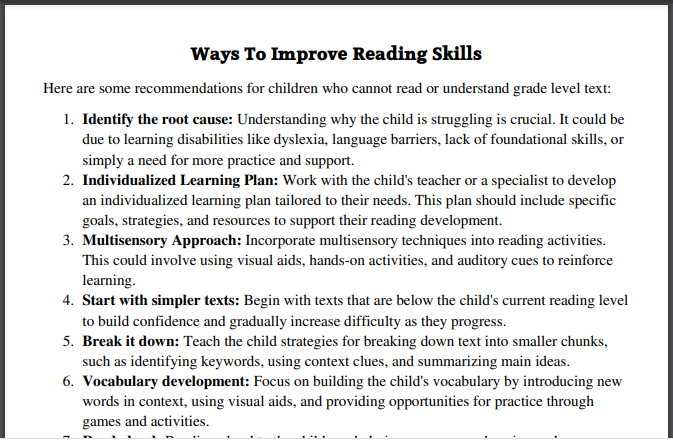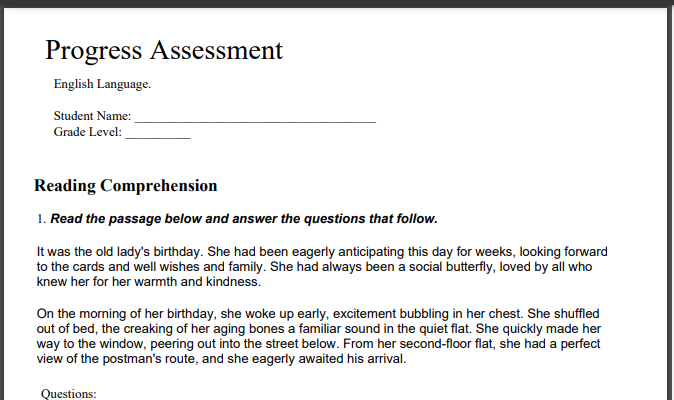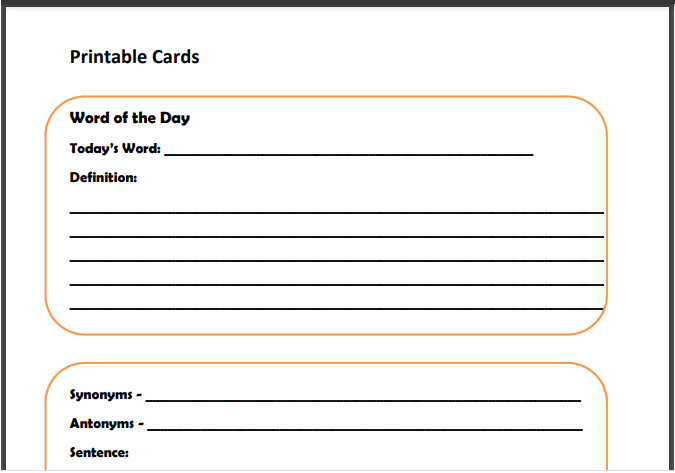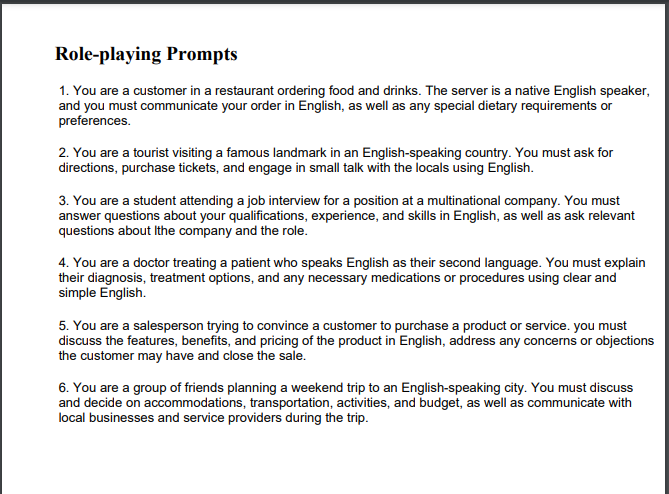Content

Video
Note: This post contains extra information in a number of PDFs links and website links.
Introduction
The Ace English programme: Exam Preparation for Kids is a guide for parents or guardians and teachers designed with specific goals and objectives to help children succeed academically. This guide will enhance children’s English language skills, and prepare them for exams and future academic endeavors. The importance of developing strong English language skills cannot be overstated, as proficiency in this subject is vital for academic success.
By participating in the Ace English program, kids will not only improve their language abilities but also build confidence and competence in their academic pursuits. This program aims to equip students with the necessary tools to excel in their English exams and beyond.
Let’s begin.
Assessment
The program should begin with determining the students’ current levels of English proficiency. This initial evaluation allows you to tailor the program to meet the specific needs of each child. In addition to the diagnostic assessment, you should conduct regular progress assessments to track improvement over time and identify areas for growth.
These assessments serve as valuable tools for both instructors and students, enabling them to focus on areas that need improvement and celebrate achievements along the way. Our goal is to provide a comprehensive and personalized learning experience that sets children up for success in their English exams. Below is a diagonostic assessment questionnaire to begin with.
Diagnostic assessment questionnaire
This questionnaire can be adapted and customized based on the age and grade level of the children being assessed. Parents or guardians and teachers can use the responses to identify areas of strength and areas needing improvement, and create a personalized learning plan to support the child’s English language development.
Click on the links below.
Diagnostic Assessment Questionnaire

Some ideas to consider when developing a reading plan

Throughout the program you should also assessment the student’s language skills to ensure continual growth. Here is a Progress Assessment for English Language Skills (Sample for students in Grade 3-5).
Progress Assessment for English Language Skills

For the above assessment, there are four sections. Each section should carry 25%. The exam has a 100%. Don’t forget, this exam should be timed as well. Below is a scoring rubric you can use.
Scoring Rubric
- Excellent (90-100%): Demonstrates mastery of the skill consistently
- Proficient (75-90%): Shows understanding of the skill with minor errors
- Developing (50% – 76%) points): Makes some progress but needs improvement
- Emerging (<50%): Shows limited understanding and requires significant support
This type of assessment can be administered on a regular basis (e.g. monthly or quarterly) to monitor progress, identify areas for growth, and provide targeted feedback and support for children’s English language development. Teachers and parents can use the assessment results to adjust instruction, set learning goals, and track improvement over time.
III. Language Development Strategies and Practices
There are a comprehensive and effective tools that can help the student enhance their language skills. You should utilize these innovative techniques and approaches as they can help learners of all levels grow their linguistic abilities. By fostering a supportive learning environment and implementing proven methodologies, this program helps individuals build confidence in their communication skills and expand their vocabulary.
From interactive language exercises to immersive learning experiences, the program encourages active engagement and continuous improvement. With a focus on practical application and real-world scenarios, students become equip with the tools they need to excel in their language development journey.
Reading comprehension strategies
Here are five top reading comprehension strategies that can help children improve their understanding of English texts:
1. Previewing
Before reading a text, have children preview the title, headings, and any visuals (such as images or diagrams) to get an overview of what the text is about. Encourage them to make predictions about the content based on these cues, which can help activate their prior knowledge and set the stage for comprehension.
2. Making Connections
Encourage children to make connections between the text and their own experiences, other texts they have read, or current events. This can help them relate to the content on a personal level and deepen their understanding of key ideas and themes.
3. Asking Questions
Teach children to ask themselves questions before, during, and after reading to guide their comprehension. Encourage them to think about the main idea, key details, and unknown vocabulary as they read, and to clarify any confusion by asking questions or seeking further information.
4. Visualizing
Prompt children to create mental images or visual representations of the text as they read. Encourage them to imagine the characters, settings, and events in the story, which can enhance their comprehension and engagement with the material. If they enjoy drawing, they can try drawing the characters as well.
5. Summarizing
After reading a text, have children summarize the main ideas, key details, and important information in their own words. This can help them consolidate their understanding, identify the most important points, and practice synthesizing information for better retention and recall.
By incorporating these reading comprehension strategies into their practice, children can become more effective and confident readers, improve their overall comprehension skills, and enhance their ability to engage with a variety of English texts.
Vocabulary building exercises
In the pursuit of mastering the English language, vocabulary building exercises play a crucial role in expanding one’s linguistic repertoire. These exercises serve as a foundation for effective communication and comprehension in various contexts. By engaging in activities that focus on learning new words and their meanings, individuals can enhance their language skills and express themselves more confidently.
Through consistent practice and exposure to a diverse range of vocabulary, learners can improve their writing and speaking abilities. Vocabulary building exercises not only help in developing a rich and nuanced language proficiency but also enable individuals to articulate their thoughts and ideas more effectively.
Here are five top vocabulary building exercises for children.
1. Word of the Day
Introduce a new word to children each day and have them learn and use it in a sentence. Encourage them to look up the definition, synonyms, and antonyms of the word, and to create their own sentences or stories using the word to deepen their understanding and retention.
2. Vocabulary Flashcards
Create flashcards with words on one side and definitions or images on the other. Have children review the flashcards regularly, testing themselves on the meanings and practicing pronunciation. This visual and interactive exercise can help reinforce vocabulary learning and retention.
3. Word Association
Provide a list of words and ask children to brainstorm related words or concepts. Encourage them to think about synonyms, antonyms, word families, and related terms to expand their vocabulary in a meaningful and interconnected way.
4. Contextual Reading
Have children read passages or texts that contain new vocabulary words in context. Encourage them to infer the meanings of unfamiliar words based on context clues, and to use these words in their own sentences to demonstrate understanding and application.
5. Word Games
Engage children in fun word games and activities, such as crossword puzzles, word searches, or word scrambles. These games can make vocabulary building enjoyable and interactive, while challenging children to think creatively and critically about language.
By incorporating these vocabulary building exercises into their learning routine, children can enhance their English language vocabulary, improve their reading and writing skills, and develop a strong foundation for effective communication in English.
Here are some printables for Vocabulary: Word of the day cards, Vocabulary Flashcards , and Word Association List.

Grammar rules and practice
The programme also encourage the student to master grammar rules through extensive practice. Students should be guided through the intricacies of English grammar, learning essential rules and conventions in a structured manner. Through targeted drills and exercises, students can strengthen their grasp of grammar rules and develop confidence in their writing and communication skills.
Here are five top writing skills development activities that can help children improve their English language writing proficiency:
1. Journaling
Encourage children to keep a daily journal where they can freely write about their thoughts, experiences, and emotions. Journaling can help them practice expressing themselves in writing, develop their voice and style, and build confidence in their writing abilities.
Some suggested topics for kids to write about in their journals include daily reflections on their thoughts and feelings, descriptions of their favorite activities or hobbies, short stories or creative writing prompts, letters to friends or family members, and goals they want to achieve.
2. Creative Writing Prompts
Provide children with creative writing prompts or story starters to inspire their imagination and creativity. Encourage them to help improve their English language oral communication skills by engaging in the following:
- Role-Playing: Encourage children to engage in role-playing scenarios where they take on different roles and act out conversations or situations. This can help them practice using English in real-life contexts, improve their fluency, and develop their conversational skills.
- Storytelling: Have children tell a story or recount an experience to a small group or the whole class. By having them tell a story or recount an experience to a small group or the whole class, they are able to gain confidence and develop their self-expression. It can also promote active listening and empathy among peers as they engage with each other’s narratives. Overall, this activity can be a fun and interactive way for children to learn how to effectively communicate their thoughts and emotions to others.

Here are some Creative Writing prompts and ideas.
Link for children to practice Active Listening with these spoken stories.

BOOK: “FROM SCRIBBLES TO STORIES”
Buy on Amazon – US $19.00 (paperback)
Description: Creative Writing workbook for young writers who are eager to perfect their craft. This engaging and interactive book is specifically designed to help students learn the key elements of writing while making the process fun and enjoyable.
Visit: www.picoplatbooks.com for more information.
IV. Exam Preparation
Preparing for English exams can be made easier by focusing on specific strategies. This includes becoming familiar with exam formats and question types, which helps in understanding what to expect on the actual test. Additionally, learning test-taking strategies can improve efficiency and accuracy during the exam. Practice exams and timed exercises are essential in building speed and confidence in answering questions within the given time limit. Moreover, mock exams provide a valuable opportunity to simulate exam conditions and assess one’s readiness for the actual test. By incorporating these elements into one’s exam preparation routine, success in English exams can become more achievable.
Exam formats and question types
Here are some common exam formats and question types for English language assessments:
- Reading Comprehension:
- Multiple Choice: Students read a passage and answer questions by selecting the correct answer from a list of options.
- True/False: Students determine the accuracy of statements based on the information in a reading passage.
- Short Answer: Students provide brief written responses or explanations to questions related to a reading passage.
- Link to Reading Comprehension passages with questions.
2. Vocabulary and Grammar: Fill in the Blanks: Students complete sentences
Test-taking strategies
Here are six test-taking strategies to help children excel in English language exams:
1. Read the Instructions Carefully:
Make sure to read all instructions and questions thoroughly before starting the exam. Understand what is being asked and follow directions accordingly.
2. Manage Your Time:
Allocate time wisely for each section of the exam. Pace yourself to ensure that you have enough time to complete all questions and review your answers.
3. Skim and Scan:
Quickly skim the reading passages and scan for keywords
Note: This site has a few practice test papers for students. The student can take these under timed conditions. Make sure the exercises are tailored to address areas of weakness and help to overcome common challenges encountered in exams. This approach should be personalized so the student’s needs are met. This will lead to improved performance and confidence in tackling their exams. Ultimately, they will achieve their academic goals and excel in their assessments.
VI. Enrichment Activities
Enrichment activities play a vital role in enhancing students’ learning experiences. These activities are:
- Reading Comprehension activities help students develop critical thinking and analytical skills.
- Creative writing prompts encourage students to express themselves creatively and improve their writing skills. (50 Creative Writing Prompts)
- Debates and discussions provide opportunities for students to engage in meaningful conversations and develop their communication and argumentation skills. (40 Debate and Discussion Topics for students)
- Vocabulary quizzes help students expand their word knowledge and improve their language proficiency. By participating in these enrichment activities, students not only deepen their understanding of various subjects but also develop important academic and social skills that will benefit them in their educational journey and beyond.
Reading Comprehension Activities:
1. Reading Buddies: Pair students up to read a text together and discuss their thoughts and interpretations.
2. Literature Circles: Assign different roles (e.g. discussion leader, summarizer) to students who read the same book and discuss it together.
3. Book Clubs: Encourage students to read a book of their choice and participate in a book club meeting to share their insights
Parental Involvement
Parental involvement in a child’s education is crucial for their success. One way to ensure this involvement is by providing regular progress updates and feedback to parents. By keeping parents informed about their child’s academic performance, strengths, and areas needing improvement, they can offer support and guidance at home.
This open line of communication fosters a collaborative relationship between parents and teachers, leading to better outcomes for the child. When parents are aware of their child’s progress, they can celebrate achievements together and address any challenges early on. Ultimately, this proactive approach to parental involvement creates a more supportive and enriching educational experience for the student.
Supporting children’s learning at home involves various strategies to enhance their educational experience. One key approach is establishing a consistent routine that includes dedicated study time each day. Encouraging open communication and providing a positive learning environment also play a crucial role.
Parents can engage in educational activities with their children, such as reading together, working on educational apps, or exploring creative projects. Utilizing technology resources and online educational platforms can further supplement learning at home. Regularly checking in with teachers and seeking additional resources or support when needed can ensure children receive the necessary assistance. By implementing these strategies, parents can effectively support their children’s learning and academic growth outside of the classroom.
Parents can access a variety of workshops and resources designed to enhance their English language skills. These offerings aim to provide support and guidance for parents seeking to improve their language proficiency, ultimately enabling them to better engage with their children’s educational journey. Workshops cover various aspects of English language learning, including speaking, reading, writing, and comprehension.
Additionally, resources such as online tools, books, and practice exercises are made available to parents looking to further develop their skills. By participating in these workshops and utilizing the resources provided, parents can increase their confidence and proficiency in English, fostering better communication and involvement in their children’s education.
Evaluation and Feedback
Evaluation and feedback are key components in fostering academic growth and development among students. By incorporating continuous assessment and feedback from teachers, children are able to receive personalized guidance and support on their educational journey. Additionally, providing opportunities for children to reflect on their own learning allows them to actively engage with their progress and identify areas for improvement.
Moreover, parent-teacher conferences offer a valuable platform for discussing student progress, setting goals, and fostering a collaborative approach to supporting the child’s academic success. Through these practices, a holistic approach to evaluation and feedback is implemented, ensuring that students receive the necessary support and guidance to thrive in their educational endeavors.
Program Completion
Upon completion of the program, when goals are met, children are recognized for their achievements, acknowledging their hard work and dedication to learning English.
Additionally, parents or guardians and teachers should recommendation further study or resources that can help the student continue improving their language skills. They should always offer assistance and guidance even after completion. By providing recognition, recommendations, and ongoing support, the program aims to equip children with the necessary tools and resources to further enhance their language proficiency and succeed in their academic and personal endeavors.
Conclusion
We call our programe “The Ace English Program“. We wish to offers a information that could be beneficital for children to excel in English language skills. Such a program can enhance children’s language proficiency, critical thinking abilities, and exam-taking strategies. The program’s outcomes include improved performance in exams, increased confidence in English communication, and better understanding of language concepts. We also encourage continuous learning and growth in English language skills, fostering a lifelong appreciation for language and communication.
